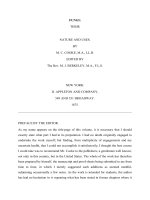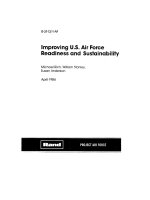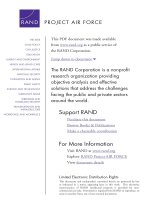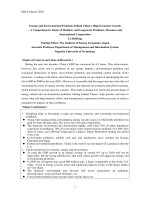Environmental Problems, Their Causes, and Sustainability
Bạn đang xem bản rút gọn của tài liệu. Xem và tải ngay bản đầy đủ của tài liệu tại đây (2.66 MB, 63 trang )
Environmental Problems,
Their Causes, and Sustainability
Chapter 1
Core Case Study: Exponential Growth (1)
Slow start, rapid increase
Human population
• 2007 ~ 6.7 billion people
Projections
• 225,000 people per day
• Add population of U.S. < 4 years
• 2050 ~ 9.2 billion people
Core Case Study: Exponential Growth (2)
Resource consumption, degradation,
depletion
Possible results
•
•
•
•
•
Huge amount of pollution and wastes
Disrupt economies
Loss of species, farm land, water supplies
Climate change
Political fallout
Living in an Exponential Age
Industrial revolution
Black Death—the Plague
Hunting
and gathering
Agricultural revolution
Industrial
revolution
Fig.Fig.
1-1,
1-1,p.
p. 15
Solutions
Understand our environment
Practice sustainability
1-1 What Is an Environmentally
Sustainable Society?
Concept 1-1A Our lives and economies
depend on energy from the sun (solar
capital) and natural resources and natural
services (natural capital) provided by the
earth.
Concept 1-1B Living sustainably means
living off earth’s natural income without
depleting or degrading the natural capital
that supplies it.
Studying Connections in Nature
Environment
Environmental science
Ecology
Environmentalism
Environmental Science
Philosophy
Ethics
and
religion
Political
science
Biology
Ecology
Economics
Chemistry
Demography
Physics
Anthropology
Geology
Geography
Fig. 1-2, p. 7
Living More Sustainably
Sustainability – central theme
Natural capital
• Natural resources
• Natural services
Natural Resources
Materials
• Renewable
• Nonrenewable
Energy
• Solar capital
• Photosynthesis
Natural Services
Functions of nature
• Purification of air, water
• Nutrient cycling
Key Natural Resources and Services
Fig. 1-3, p. 8
Nutrient Cycling
Organic
matter in
animals
Dead
organic
matter
Organic
matter in
plants
Decomposition
Inorganic
matter in soil
Fig. 1-4, p. 9
Environmental Sustainability
Trade-offs (compromises)
Sound science
Individuals matter
•
•
•
•
Ideas
Technology
Political pressure
Economic pressure
Sustainable Living from Natural Capital
Environmentally sustainable society
Financial capital and financial income
Natural capital and natural income
Bad news: signs of natural capital depletion
at exponential rates
1-2 How Can Environmentally Sustainable
Societies Grow Economically?
Concept 1-2 Societies can become more
environmentally sustainable through
economic development dedicated to
improving the quality of life for everyone
without degrading the earth’s life-support
systems.
Economics
Economic growth
Gross Domestic Product (GDP)
Per capita GDP – PPP
Economic development
Developed countries
Developing countries
Global Outlook
Percentage of
World's:
Population
18%
82%
Population 0.1%
growth
1.5%
Life
expectancy
Wealth and
income
Resource
use
Pollution
and waste
77 years
66 years
85%
15%
88%
12%
75%
25%
Fig. 1-5, p. 10
1-3 How Are Our Ecological Footprints
Affecting the Earth?
Concept 1-3 As our ecological footprints
grow, we are depleting and degrading more
of the earth’s natural capital.
Natural Resources (1)
Perpetual – renewed continuously
• Solar energy
Renewable – hours to decades
• Water, air
• Forest, grasslands
Natural Resources (2)
Sustainable yield
• Highest use while maintaining supply
Environmental degradation
• Exceed natural replacement rate









